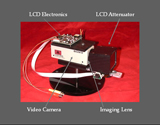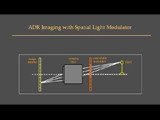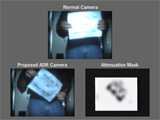Adaptive Dynamic Range Imaging |
|||
 |
|||
|
This project is focused on the development of a new approach to imaging that significantly enhances the dynamic range of an imaging system. The key idea is to adapt the exposure of each pixel on the detector based on the radiance value of the corresponding scene point. This adaptation is done in optical domain, that is, during image formation. In practice, this is achieved using a two-dimensional spatial light modulator, whose transmittance function can be varied with high resolution over space and time.
A real-time control algorithm has been developed that uses a captured image to compute the optimal transmittance function for the spatial modulator. The captured image and the corresponding transmittance function are used to compute a very high dynamic range image that is linear in scene radiance. Extensive simulations and experiments have been conducted to demonstrate this concept of adaptive dynamic range imaging. The simulation results show the ability of the control algorithm to produce stable, high quality images even when the scene changes with time. We have implemented a video-rate adaptive dynamic range (ADR) camera that consists of a color CCD detector and a controllable liquid crystal light modulator. Experiments have been conducted in a variety of scenarios with complex and harsh lighting conditions. The results indicate that adaptive imaging can impact vision applications such as monitoring, tracking, recognition and navigation. |
|||
Publicationsprint_paperentry_byid: more than 2 or no entry matches. |
|||
Pictures |
|||
Videos
|
|||
Slides |
|||
Related ProjectsProgrammable Imaging: MicroMirror Array |


